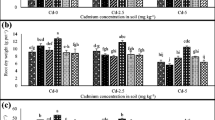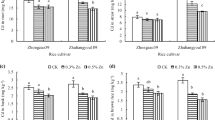Abstract
Chlorsulfuron has been reported to induce and aggravate Zn and Cu deficiency in wheat when applied to crops grown on soils with low availability of these micronutrients. In the present study, the effect of chlorsulfuron on the growth of three wheat genotypes (Triticum aestivum L., cvs Excalibur and Gatcher, and T. turgidum conv. durum (Desf.) McKay cv Durati) differing in zinc efficiency was examined in Zn-deficient sandy soil fertilised with 0 or 0.8 mg Zn kg-1 soil. Excalibur has previously been identified as the Zn-efficient genotype which can take up more Zn and has higher yield in soils with low plant-available Zn, while Gatcher and especially Durati are Zn-inefficient genotypes. Chlorsulfuron reduced the shoot dry weight but not root dry weight. Zn concentration and content in shoots and roots were reduced by chlorsulfuron when applied with 0.8 mg Zn kg-1 soil. Copper concentration was reduced by Chlorsulfuron in roots but not in shoots. Chlorsulfuron reduced the growth rate of the third leaf, decreased the total length of roots (especially the length of fine roots with diameter ≤ 0.2 mm), and increased the average root diameter, more so in the Zn-inefficient genotype Durati than in the other two genotypes. Gatcher is the genotype most tolerant to chlorsulfuron among the three wheat genotypes judged by its root system being less affected by chlorsulfuron. Excalibur grew well at the three-leaf stage (growth rate of the third leaf was not significantly inhibited by chlorsulfuron) but not better than Gatcher later because of inhibition of root growth by chlorsulfuron. The results indicate that Zn-efficiency trait of plants may contribute to the tolerance to chlorsulfuron but still there are other mechanisms involved. The reduced content of Zn or Cu may be a consequence of reduced growth of plant roots and alteration of root geometry or morphology because the net uptake rates (based on root surface area) of these micronutrients were not reduced by chlorsulfuron.
Similar content being viewed by others
References
Beyer E M, Duffy M J, Hay J V and Schlueter D D 1988 In Herbicides: Chemistry, Degradation and Mode of Action. Eds. P C Kearney and D D Kaufman. pp 117–189. Marcel Dekker, New York.
Bowen J E 1969 Absorption of copper, zinc and manganese by sugarcane tissue. Physiol. 44, 255–261.
Bowran D G and Blacklow W M 1987 Sensitivities of spring wheat cultivars to chlorsulfuron were measured as inhibitions of leaf elongation rates and there were genotype × environment interactions. Aust. J. Agric. Res. 38, 253–262.
Devine M D, Bestman H D and Vanden Born W H 1990 Physioloical basis for the different phloem mobilities of chlorsulfuron and clopyralid. Weed Sci. 38, 1–9.
Graham R D, Ascher J S and Hynes S C 1992 Selecting zinc-efficient cereal genotypes for soils of low zinc status. Plant and Soil 146, 241–250.
Hance R J 1981 Effects of pesticides on plant nutrition. Residue Rev. 78, 13–41.
Harris G A and Campbell G S 1989 Automated quantification of roots using a simple image analyzer. Agron. J. 81, 935–938.
Kirchhof G 1992 Measurement of root length and thickness using a hand-held computer scanner. Field Crops Res. 29, 79–88.
Lemerle D 1993 Influence of rainfall and temperature on sensitivity of barley (Hordeum vulgare) to chlorsulfuron. Aust. J. Agric. Res. 44, 23–32.
Marschner H 1993 Zinc uptake from soil. In Zinc in Soils and Plants. Ed. A D Robson. pp 59–77. Kluwer Acad. Publ., Dordrecht.
McLay L D and Robson A D 1992 The effect of chlorsulfuron and diclofop-methyl on the uptake and utilization of zinc by wheat. Aust. J. Agric. Res. 43, 59–65.
Nable R O and Webb M J 1993 Further evidence that zinc is required throughout the root zone for optimal plant growth and development. Plant and Soil 150, 247–253.
O'Keeffe P and Wilhelm N 1993 The hidden costs of herbicide use on micronutrient poor soils. In Proceedings of the Australian Agronomy Conference. Eds. G K McDonald and W T Bellotti. pp 154–157. Aust. Soc. Agron. Parkville, Vic., Australia.
Osborne L D and Robson A D 1992 Duration of zinc uptake inhibition by chlorsulfuron in wheat. Aust. J. Agic. Res. 43, 1169–1174.
Osborne L D, Robson A D and Bowran D G 1993 The impact of chlorsulfuron and diclofop-methyl on nutrient uptake by wheat. Aust. J. Agric. Res. 44, 1757–1766.
Pederson R N, Black I D, Dyson C B and Hannam R J 1994 Effects of the herbicide metsulfuron-methyl on root length, nutrient levels, grain protein, and yield of barley. Aust. J. Exp. Agric. 34, 499–504.
Ray TB 1984 Site of action of chlorsulfuron. Inhibition of valine and isoleucine biosynthesis in plants. Plant Physiol. 75, 827–831.
Robson A D and Snowball K 1990 The effect of chlorsulfuron on the uptake and utilization of copper and zinc in wheat. Aust. J. Agric. Res. 41, 19–28.
Römheld V and Marschner H 1991 Function of micronutrients in plants. In Micronutrients in Agriculture, 2nd ed. Eds. J J Mortvedt, F R Cox, L M Shuman and R M Welch. pp 297–328. SSSA Inc., Madison, WI.
Schmid W E, Haag H P and Epstein E 1965 Absorption of zinc by excised barley roots. Physiol. Plant. 18, 860–869.
Sllanpää M and Vlek P L G 1985 Micronutrients and agroecology of tropical and mediterranean regions. Fert. Res. 7, 151–167.
Smith A E and Hsiao A I 1985 Transformation and persistence of chlorsulfuron in Prairie field soils. Weed Sci. 33, 555–557.
Williams R F 1984 The effect of P supply on the rates of intake of P and nitrogen and upon certain aspects of P metabolism in graminaceous plants. Aust. J. Sci. Res. (B) 1, 333–361.
Zhanow E W 1982 Analysis of the herbicide chlorsulfuron in soil by liquid chromatography. J. Agric. Food. Chem. 30, 854–857.
Author information
Authors and Affiliations
Rights and permissions
About this article
Cite this article
Dong, B., Rengel, Z. & Graham, R.D. Effects of herbicide chlorsulfuron on growth and nutrient uptake parameters of wheat genotypes differing in Zn-efficiency. Plant Soil 173, 275–282 (1995). https://doi.org/10.1007/BF00011465
Received:
Accepted:
Issue Date:
DOI: https://doi.org/10.1007/BF00011465




